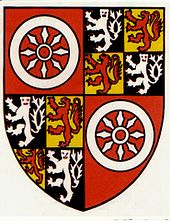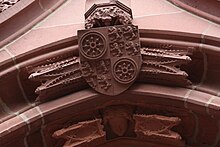Konrad von Dhaun
Konrad von Dhaun (* around 1380 , † 1434 ), from the house of the Wild and Rhine Counts , was called Konrad III. from 1419 to 1434 elector and archbishop of Mainz . His term of office was marked by the Hussite Wars and by heavy disputes both with the Landgraviate of Hesse and with and within the city of Mainz .
Life
Rise to Archbishop
1390 was "Conradus Comes in Důn et dominus in Ringreuenstein" together with his older brother Johann III. von Dhaun (* around 1371; † 1428) matriculated at the University of Heidelberg . Konrad became a canon in Mainz in 1396 . In 1414 he became provost of the Imperial Cathedral of St. Bartholomew in Frankfurt am Main and Mainz bailiff for the Eichsfeld at Rusteberg Castle near Heiligenstadt . On October 10, 1419 he was elected Archbishop of Mainz, albeit at Ehrenfels Castle , as the Mainz citizenship was hostile to the clergy . On 15 December 1419 he was selected by Pope Martin V. confirmed.
Imperial politics
In August 1421 Konrad went with the so-called Second Hussite Crusade , together with Archbishop Dietrich II of Cologne and Count Palatine Ludwig III. , via Eger to Bohemia , where he took part in the siege of Žatec (Saaz), which ended on October 2nd with a wild flight of the imperial army when a rumor arose that a Hussite relief army was approaching.
On the Reichstag in Nuremberg on August 25, 1422 King appointed him Sigismund the imperial vicar , but given the resistance of the Count Palatine Ludwig and other imperial estates put Konrad the office as early as May 1423 down again. (The Golden Bull of 1356 made the Elector of the Palatinate binding as imperial vicar for the areas under Franconian law .) In 1424 he belonged to the opposition of the Electors, who formed the Binger Kurverein against King Sigismund .
In 1429 Konrad traveled to Pressburg in order to take part in King Sigismund's negotiations with the leaders of the Hussites in his function as Imperial Chancellor .
Battle with Hessen
The Archdiocese of Mainz had already been in dispute with the Hessian landgraves over territorial supremacy in Hesse for two centuries, and in 1427 Konrad declared war again, this time because of a deposit due to the County of Waldeck , but also because of the disputes in the Fulda Abbey between Prince Abbot Johann I von Merlau and Archbishop Konrad's close friend, Coadjutor Hermann II von Buchenau . Count Gottfried von Leiningen (a younger relative of the cathedral provost of the same name) devastated the north Hessian area around Gudensberg , Felsberg and Melsungen from the Mainz enclave Fritzlar with 600 horsemen and additional foot troops , but was then decided by Landgrave Ludwig I on 23 July In 1427, between the village of Großenenglis and today's deserted area of Holzheim, a few kilometers south of Fritzlar and then again defeated in pursuit battles near Jesberg, Felsberg and Fritzlar. Leiningen withdrew to Fulda , where Archbishop Konrad himself was already standing with a second army. However, the monastery and city of Fulda refused to give him and his people protection within the city walls, and his army was once again decisively defeated on August 10th. This lost Mainz-Hessian War and the peace treaty concluded in Frankfurt on December 8, 1427, marked the end of the Mainz hegemonic efforts in northern Hesse. Mainz then had to take almost all of its possessions in Lower and Upper Hesse as fiefs from Hesse (with the exception of Fritzlar, Naumburg , Amöneburg and Neustadt ).
Dispute in Mainz
In Mainz itself there were violent disputes between the patriciate and the guilds and tensions between the citizens and the clergy only a few years later . In 1430 the patricians left the city in anger. When the city also taxed the clergy in 1432, the clerics also moved out of the city in 1433. On May 14, 1434 Konrad imposed the excommunication on the city.
death
However, Konrad died soon afterwards, on June 10, 1434, and was buried in the cathedral of Mainz . His grave monument was probably created by Madern Gerthener , whom he had already commissioned with the creation of the grave monument of his predecessor and who was known to him from his time as provost in St. Bartholomew.
literature
- Karl Georg Bockenheimer : Konrad III., Wild and Rhine Count of Daun . In: Allgemeine Deutsche Biographie (ADB). Volume 16, Duncker & Humblot, Leipzig 1882, p. 596 f.
Web links
- Conrad III. by Dhaun on regionalgeschichte.net
Individual evidence
- ↑ Kaspar Friedrich Gottschalck: The knight castles and mountain castles of Germany. Volume 6 Hemmerde and Schwedschke, Halle, p. 18.
- ^ Jacques Baudoin: La sculpture flamboyante. Les grands imagiers d'Occident , Èditions créer, 1983, ISBN 2-902894-15-5
- ↑ Horst Reber: Madern Gerthener and the tomb of Archbishop Konrad von Dhaun in Mainz Cathedral. In: Daniela Christmann (Ed.): RückSicht. Festschrift for Hans-Jürgen Imiela on February 5, 1997. Schmidt, Mainz 1997, ISBN 3-87439-420-4 , pp. 59-62.
| predecessor | Office | successor |
|---|---|---|
| Johann II of Nassau |
Elector Archbishop of Mainz 1419–1434 |
Dietrich Schenk von Erbach |
| personal data | |
|---|---|
| SURNAME | Konrad von Dhaun |
| ALTERNATIVE NAMES | Conrad III. from Dhaun |
| BRIEF DESCRIPTION | German clergyman, Archbishop of Mainz (1419–1434) |
| DATE OF BIRTH | around 1380 |
| DATE OF DEATH | buried June 10, 1434 |

